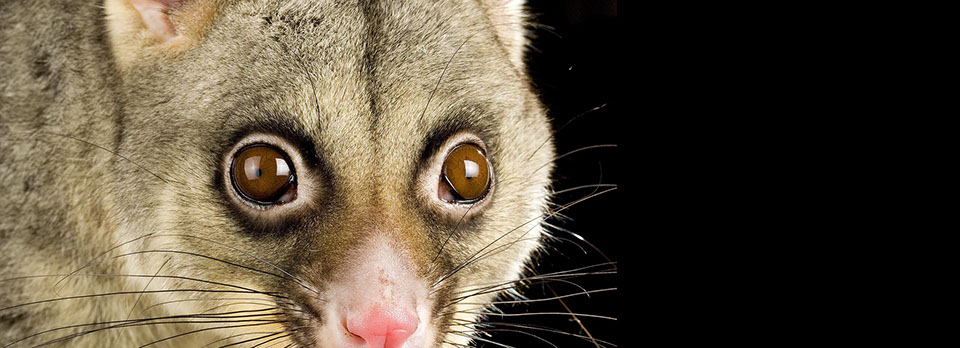
Nic Bishop
Author and Photographer
of Nature Books for Children
Book Notes - Taking the Photographs for Nic Bishop Lizards
Each new book that I work on in this series presents new challenge, and the lizard bank was no exception. In fact, many of the photos in this book were my most challenging yet. I’ll describe taking some them here.
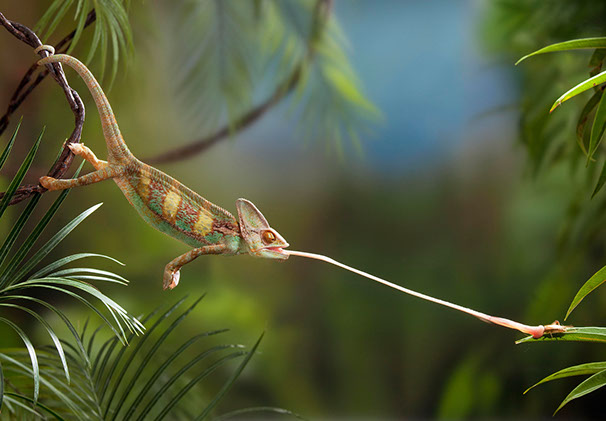
For technical reasons (the use of sensitive laser triggers, shutters and high speed flash guns) this chameleon picture was taken In a studio. My first task was to find a chameleon willing to eat in front of my camera equipment. Chameleons are notoriously shy and idiosyncratic animals, and at times are completely unfathomable. Yet, I needed just the right one for what I had In mind here, so I “auditioned” several potential stars before finding this veiled chameleon with an insatiable appetite.
Next I had lo create a suitable forest setting for the photograph. Veiled chameleons have an unusual and limited distribution, being found In Yemen and parts of Saudi Arabia (although mine was a captive animal, born and raised In the US). After some research I created a dry, open, sunny forest type (with palms and narrow-leaved plants), such as might be found near water In that part of the world. Each component of the vegetation was placed for composition. The three dimensional depth of the “forest” and its sunlit feel required using 11 calibrated flash guns (I had to borrow some and resurrect others).
Eventually I had the setting I wanted. Now it was up to the chameleon. I put him on his branch and he obligingly downed crickets, one after another. Each time that tongue hit a target it also crossed a laser beam which triggered my camera and flash guns. At first, I placed the chameleon relatively close to the cricket, so he could reach his dinner while keeping all four legs on his branch. The photos were perfectly good, and I could have been justifiably satisfied, but I knew I wanted something more. I wanted to show how athletic and acrobatic these animals can be when there is food at stake. And I wanted to illustrate the use of that incredibly powerful prehensile tail.
So, each day I moved the chameleon’s branch a little further from the cricket at feeding time, which meant he had to stretch more from his branch to reach. Eventually (about 6 weeks after starting the project, and well over 120 crickets later) I knew I had him feeding at full stretch. If I put that cricket just half an inch more the right, the chameleon would just stay on his branch and give me a grumpy look - until I nudged it back into range
I look several good shots. In some the tongue hit with such force that the cricket would literally explode. But In the end I chose this picture for the wonderfully aesthetic curve of the chameleon’s powerful taiI and body, the counterbalance of palm fronds, and the gorgeous blush of colors that the chameleon turned in anticipation of his meal (and the sheer exertion of reaching it).
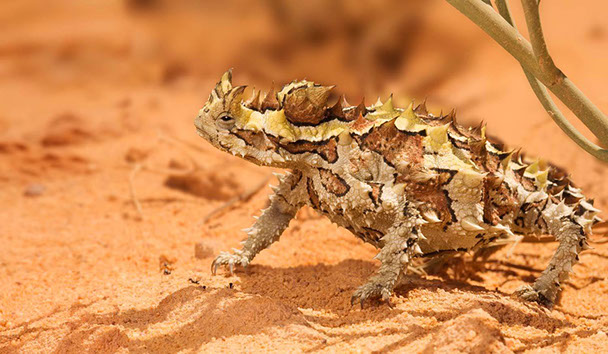
Taking the picture above wasn't difficult. The hard part was finding the lizard in the first place. This is a thorny devil, which as I explained In my book, lives only in remote deserts in Australia. It’s also rare, so you are lucky to come across one. And It looks just like a small prickly stick, which are lying around everywhere in the desert, so you probably wouldn’t notice one even if you walked right past it.
Searching for such an animal in the wild Is a huge commitment of time and travel expenses, especially when there Is no guaranteed outcome. I have described the story of this photo in my book, so l won’t go into details here, but needless to say I ended up driving for days through the desert, kicking myself for being so foolishly optimistic as to believe I might actually find a thorny devil.
While searching, there were some highlights. At sunset we would often spot Euros, the most hardy and desert-adapted of the kangaroos. We had fun tracking monitor lizards across the dunes, and sometimes surprised one, busy hunting. Emus would strut past, including a delightful dad and family (the male does all the parenting). Then, at last, I came round a corner and there it was. A prickly stick with legs. My brain was so “tuned in" wanting to see a thorny devil (it had been on my “must see” list of animals for well over a decade) that at first I could hardly believe it. I wondered if it had materialized like a mirage. But it was indeed very real, and every bit as amazing as I had hoped.
Very much later I read about a well known herpetologist who had traveled across Australia for many thousands of miles and many months, before he found a thorny devil. I guess I can count myself lucky.
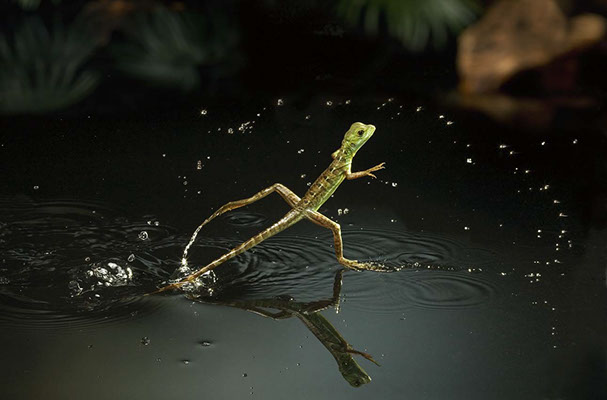
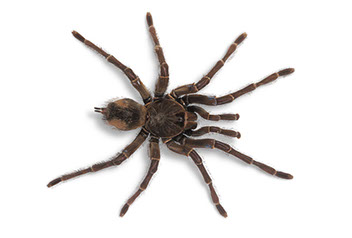
The ability of a basilisk lizard to run on water is one of nature's wonders. I just had to try and photograph it for my book. But the question was . . . how? I didn't have any guaranteed answers to this. I just hoped that I might figure things out as I went along . . .
What I did know was that I'd have to take the photograph under relatively controlled conditions, given the high-speed, split-second timing involved. So l built a pond in my garage, fitted with large aquarium heaters (I didn't want my subjects to get chilled). Then I carefully set up strobes to recreate the dappled light-and-dark ambience of the rainforest floor, while strategically lighting darker areas behind where the lizard would run, so the droplets of water would stand out for maximum effect. Finally, I installed a laser trip-beam close to the water's surface, to fire the camera when the lizard ran through it.
All this seems simple in hindsight, but getting the lighting and everything else perfect took several weeks. Now everything depended on the lizards, which I obtained from a captive breeder. This was where I suspected things might get tricky. I kept the lizards In my house and brought one out to the garage. After some gentle words of encouragement I showed it the pond, whereupon it dived in and swam like a fish to the bottom. No matter what I tried - building take-off ramps, creating bushy hideouts to run to, swapping lizards - my subjects would only ever swim. They never ran on the surface.
I had tried anticipating almost every nuance of lizard behavior, and was almost out of ideas, when I wondered if it was taking me too long to carry a lizard from the house to the garage. Perhaps during the delay its instinct somehow switched from run to swim. The only solution to this was to move the pond from the garage and put it in the house, right next to the lizard cage. Of course, ponds are not typical indoor decor items, nor practical, especially in a loft where my lizard cage was. But what choice did I have?
More than eight weeks had passed by the time l was ready for round two, indoors. I plucked a basilisk from its cage, took a deep breath, and then very thankfully watched it take off across the water like a skipping stone. I took many photos over the next week or two (I had several sibling lizards as stand ins, so as to never tire any individual) and this photo turned out the best. The lizard is perfectly posed and I love the way it is framed in a glorious semicircle of sparkling droplets that have spun off its feet.
After all the weeks of uncertainty it was amazing to see just how well these lizards could run across water. Often they would jump from one stride to the next, with both feet in the air. And even if they became submerged up to their elbows in water, they could still climb onto the surface and speed away.
Text and Images - Copyright Nic Bishop